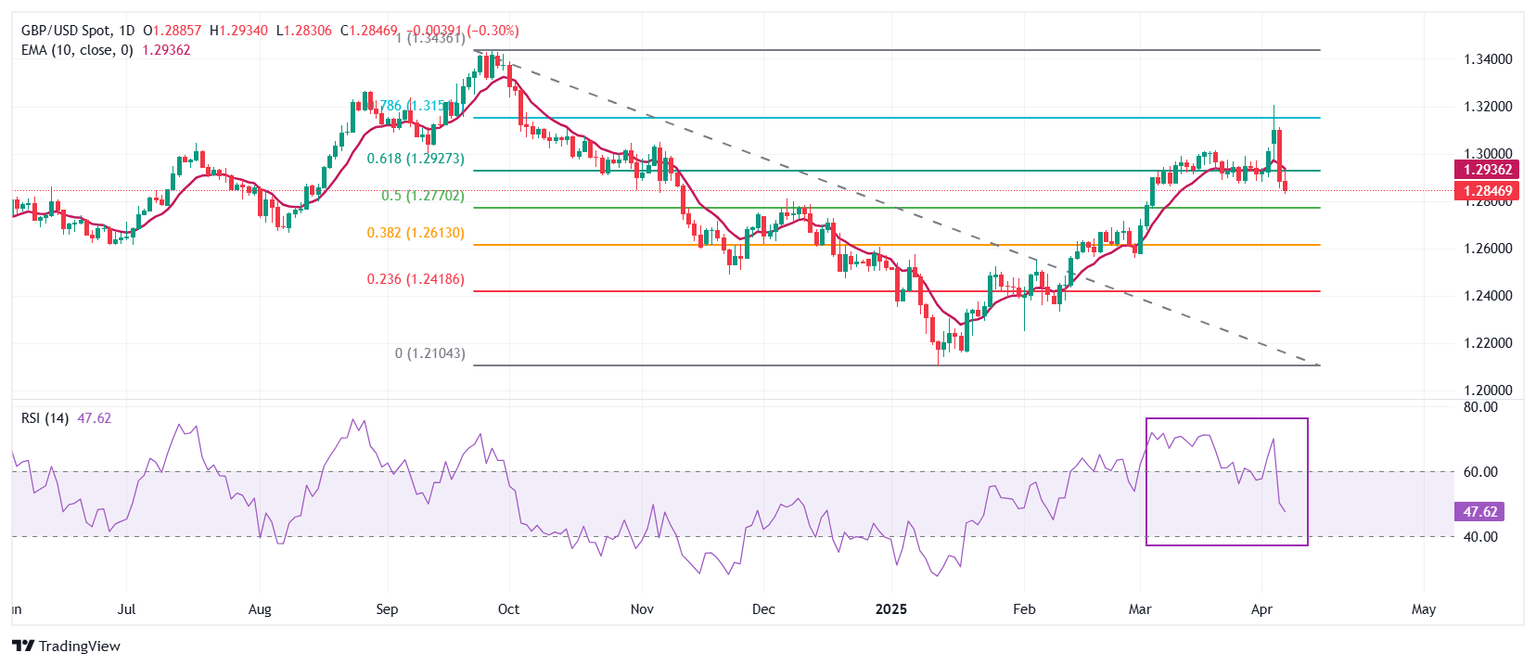Pound Sterling slumps as Trump tariffs send shockwaves to global economy
- The Pound Sterling surrenders intraday recovery against the US Dollar despite US economic uncertainty.
- Investors have become increasingly confident that the US economy could enter a recession.
- UK PM Starmer vows to shelter domestic firms from potential global trade war.

The Pound Sterling (GBP) gives up its intraday recovery move and tumbles to near 1.2800 against the US Dollar (USD) during Monday’s North American session, the lowest level seen in a month. The GBP/USD pair faces an intense sell-off as the US Dollar strives to gain ground, with the US Dollar Index (DXY), which tracks the Greenback’s value against six major currencies, aiming to hold above 103.00.
The outlook of the US Dollar remains uncertain as financial market participants have become increasingly concerned over the United States (US) economic outlook, with Federal Reserve (Fed) Chair Jerome Powell warning that larger-than-expected tariffs imposed by President Donald Trump on Wednesday could lead to a resurgence in inflation and slower economic growth. "We face a highly uncertain outlook with elevated risks of both higher unemployment and higher inflation," Powell said in his prepared remarks at the annual conference for the Society for Advancing Business Editing and Writing on Friday.
When asked about the impact of Trump’s tariffs on the monetary policy outlook, Powell continued with the “wait and see” approach and said, "The Fed is well-positioned to wait for greater clarity before considering policy adjustments."
Meanwhile, market experts now see a greater chance that Trump’s sweeping, harsh-than-expected tariffs on US trading partners could push the US economy into a recession. Investment banking firms Goldman Sachs and JP Morgan have raised the probability of the US entering a recession to 45% and 60%, respectively.
This week, investors will focus on the US Consumer Price Index (CPI) data for March, which will be released on Thursday. The impact of the US CPI data is expected to be limited in the US Dollar unless there is a dramatic change, as market expectations for the Fed’s monetary policy outlook will likely be driven by tariff-led consumer inflation expectations.
Daily digest market movers: Pound Sterling weakens against US Dollar
- The Pound Sterling exhibits highly volatile action against its peers at the start of the week. The British currency is impacted by Trump’s tariffs-driven uncertainty that is expected to batter the United Kingdom’s (UK) economy strongly.
- UK firms are expected to face significant competition in the global market as business owners from nations slapped with significantly higher tariffs by the US would look for other markets for their products. Such a scenario would be unfavorable for a country that is already struggling to cope with tight financial conditions.
- The Bank of England (BoE) is maintaining a strict “gradual and cautious” stance on further monetary policy easing as inflationary pressures remain significantly far from the desired rate of 2%. The odds of UK inflation easing in the near term are at least as BoE officials have already warned that price pressures could accelerate before returning to the 2% path due to higher energy prices.
- Meanwhile, UK Prime Minister Keir Starmer has vowed to protect domestic firms from the storm of Trump tariffs. "We stand ready to use industrial policy to help shelter British business from the storm," Starmer said over the weekend, Reuters report. Starmer also indicated that he wants to strengthen alliances and reduce trade barriers.
- This week, investors will focus on the monthly Gross Domestic Product (GDP) and the factory data for February, which will be released on Friday.
Technical Analysis: Pound Sterling slumps below 20-day EMA

The Pound Sterling struggles to recover after sliding to near 1.2820 against the US Dollar on Monday. The GBP/USD pair falls below the 20-day Exponential Moving Average (EMA), around 1.2930, indicating that the near-term trend has become uncertain.
The 14-day Relative Strength Index (RSI) falls below 60.00, indicating that the bullish momentum is over. However, the bullish bias is intact until it holds the 40.00 level.
Looking down, the 50% Fibonacci retracement plotted from late September high to mid-January low near 1.2770 will act as a key support zone for the pair. On the upside, the April 3 high of 1.3207 will be a key resistance zone.
Fed FAQs
Monetary policy in the US is shaped by the Federal Reserve (Fed). The Fed has two mandates: to achieve price stability and foster full employment. Its primary tool to achieve these goals is by adjusting interest rates. When prices are rising too quickly and inflation is above the Fed’s 2% target, it raises interest rates, increasing borrowing costs throughout the economy. This results in a stronger US Dollar (USD) as it makes the US a more attractive place for international investors to park their money. When inflation falls below 2% or the Unemployment Rate is too high, the Fed may lower interest rates to encourage borrowing, which weighs on the Greenback.
The Federal Reserve (Fed) holds eight policy meetings a year, where the Federal Open Market Committee (FOMC) assesses economic conditions and makes monetary policy decisions. The FOMC is attended by twelve Fed officials – the seven members of the Board of Governors, the president of the Federal Reserve Bank of New York, and four of the remaining eleven regional Reserve Bank presidents, who serve one-year terms on a rotating basis.
In extreme situations, the Federal Reserve may resort to a policy named Quantitative Easing (QE). QE is the process by which the Fed substantially increases the flow of credit in a stuck financial system. It is a non-standard policy measure used during crises or when inflation is extremely low. It was the Fed’s weapon of choice during the Great Financial Crisis in 2008. It involves the Fed printing more Dollars and using them to buy high grade bonds from financial institutions. QE usually weakens the US Dollar.
Quantitative tightening (QT) is the reverse process of QE, whereby the Federal Reserve stops buying bonds from financial institutions and does not reinvest the principal from the bonds it holds maturing, to purchase new bonds. It is usually positive for the value of the US Dollar.
Author

Sagar Dua
FXStreet
Sagar Dua is associated with the financial markets from his college days. Along with pursuing post-graduation in Commerce in 2014, he started his markets training with chart analysis.

















